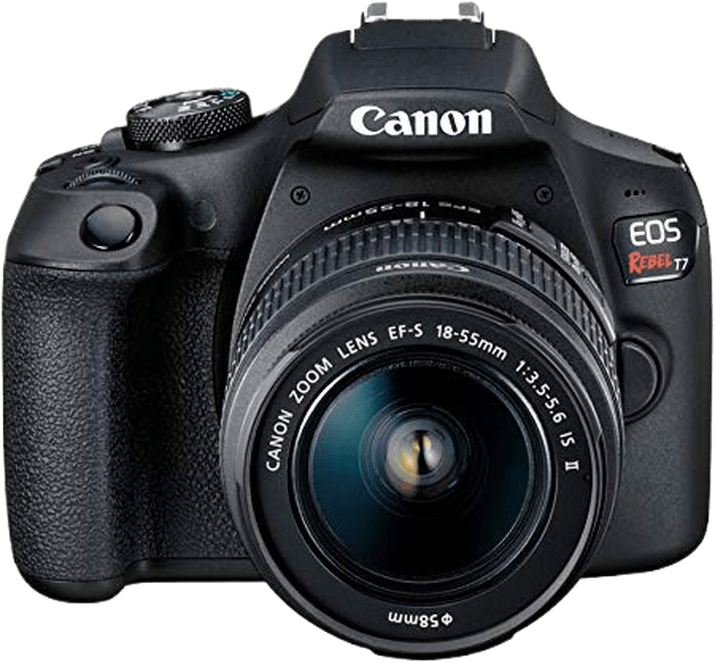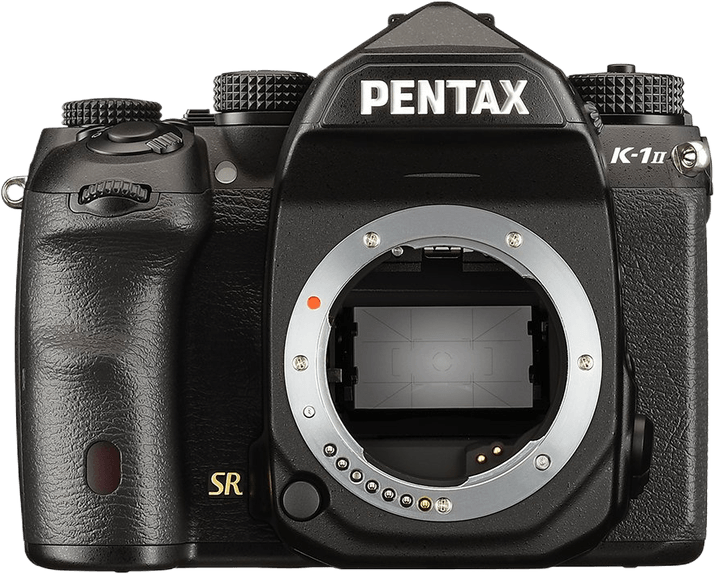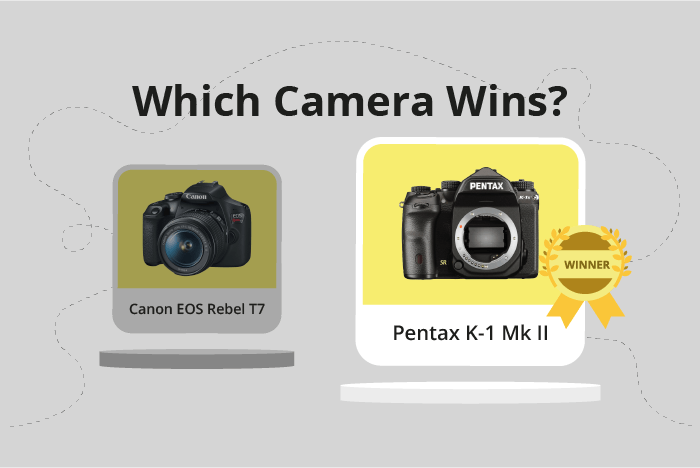Canon EOS Rebel T7 / 2000D vs Pentax K-1 Mark II Comparison
Canon EOS Rebel T7 / 2000D

Pentax K-1 Mark II

The Pentax K-1 Mark II outperforms the Canon EOS Rebel T7 / 2000D with a score of 80/100 compared to 50/100. Both cameras are DSLRs released in 2018, with the Canon T7 priced at $550 and the Pentax K-1 Mark II at $1999. They share similar dimensions, with the Canon T7 measuring 129 x 101 x 78mm and weighing 660g, while the Pentax K-1 Mark II measures 137 x 110 x 86mm and weighs 1010g.
The Pentax K-1 Mark II excels due to its superior performance and features, justifying its higher price. On the other hand, the Canon T7 offers a more affordable option for those on a budget, while still providing quality results for casual photographers.
Considering the specifications and scores, the Pentax K-1 Mark II is the better option for professional and serious photographers, while the Canon T7 is a suitable choice for beginners or those seeking a budget-friendly DSLR.
Canon EOS Rebel T7 / 2000D vs Pentax K-1 Mark II Overview and Optics
The Pentax K-1 Mark II emerges as the clear winner in the optics comparison with a score of 85/100, outperforming the Canon EOS Rebel T7 / 2000D by 29 points, which scored 56/100. Both cameras share common specifications such as a CMOS sensor and compatibility with various lenses through their respective lens mounts, Canon EF-S and Pentax KAF4.
The Pentax K-1 Mark II boasts superior specifications, including a higher megapixel count of 36 compared to the Canon T7’s 24.1, which enables it to capture more details in images. It also has a faster shooting speed of 4.4 frames per second (fps) as opposed to the Canon T7’s 3 fps, allowing for better performance in continuous shooting. The Pentax K-1 Mark II’s full frame sensor size and impressive DXOMARK score of 96 further contribute to its superior image quality. Additionally, it features image stabilization, providing an advantage in capturing sharp images in various conditions.
While the Canon T7 falls short in several aspects, it does offer a lightweight and compact design compared to the Pentax K-1 Mark II. This makes it more convenient for travel and casual photography.
In terms of optics, the Pentax K-1 Mark II outshines the Canon EOS Rebel T7 / 2000D with its higher megapixel count, faster shooting speed, better sensor size, and image stabilization. However, the Canon T7 might appeal to those seeking a lighter and more compact camera. Ultimately, the choice depends on the user’s priorities and preferences.
Canon EOS Rebel T7 / 2000D vs Pentax K-1 Mark II Video Performance
The Pentax K-1 Mark II outperforms the Canon EOS Rebel T7 / 2000D in video capabilities with a significant difference of 27 points, scoring 70/100 to the Canon’s 43/100. Both cameras share the same maximum video resolution of Full HD and video dimensions of 1920 x 1080, but the similarities end there.
The Pentax K-1 Mark II boasts a higher maximum video frame rate, offering 60fps compared to the Canon’s 30fps. This means the Pentax K-1 Mark II has smoother and more detailed video recording. Additionally, the Pentax K-1 Mark II has built-in time-lapse functionality, which the Canon EOS Rebel T7 / 2000D lacks. This feature allows users to create captivating time-lapse videos directly within the camera.
While the Canon EOS Rebel T7 / 2000D falls short in comparison to the Pentax K-1 Mark II, it is essential to consider the camera’s primary focus. The Canon EOS Rebel T7 / 2000D is a beginner-friendly DSLR designed for entry-level users who may prioritize photography over videography. As such, its video capabilities may suffice for casual users who do not require advanced video features.
Considering the video capabilities of both cameras, the Pentax K-1 Mark II is the clear winner for users seeking advanced video features, such as a higher frame rate and built-in time-lapse functionality. However, for those who prioritize photography and only require basic video capabilities, the Canon EOS Rebel T7 / 2000D may still be a suitable option.
Canon EOS Rebel T7 / 2000D vs Pentax K-1 Mark II Features and Benefits
The Pentax K-1 Mark II outperforms the Canon EOS Rebel T7 / 2000D in features, scoring 72/100 compared to the Canon’s 41/100. Both cameras share some common specifications, such as a flip screen, WiFi connectivity, and the absence of a touchscreen.
The Pentax K-1 Mark II excels in several aspects. It has a larger screen size of 3.2 inches compared to the Canon’s 3 inches, providing a more comfortable viewing experience. Additionally, the Pentax’s screen resolution is higher at 1,037,000 dots, compared to the Canon’s 920,000 dots, resulting in clearer and sharper images. The Pentax K-1 Mark II also includes GPS and Bluetooth capabilities, while the Canon EOS Rebel T7 / 2000D lacks both.
On the other hand, the Canon EOS Rebel T7 / 2000D does not have any significant advantages over the Pentax K-1 Mark II concerning features. Both cameras lack a touchscreen, which could be seen as a drawback for users who prefer that functionality.
In comparing the features of the Canon EOS Rebel T7 / 2000D and the Pentax K-1 Mark II, it is evident that the Pentax K-1 Mark II is the superior camera. Its larger screen size, higher screen resolution, and the presence of GPS and Bluetooth capabilities contribute to its higher feature score. The Canon EOS Rebel T7 / 2000D lacks any distinct advantages in this comparison, making the Pentax K-1 Mark II the clear winner.
Canon EOS Rebel T7 / 2000D vs Pentax K-1 Mark II Storage and Battery
The Pentax K-1 Mark II outperforms the Canon EOS Rebel T7 / 2000D in storage and battery, with a score of 65/100 compared to the Canon’s 27/100. Both cameras share common specifications, such as accepting SD, SDHC, and SDXC memory cards, and lacking USB charging capabilities.
The Pentax K-1 Mark II excels with its dual memory card slots and a longer battery life of 670 shots, using the D-LI90 battery type. This provides greater flexibility and extended shooting time for users. On the other hand, the Canon EOS Rebel T7 / 2000D has only one memory card slot and a shorter battery life of 500 shots, utilizing the LP-E10 battery type.
Despite its lower score, the Canon EOS Rebel T7 / 2000D may still be sufficient for casual photographers who do not require extended battery life or multiple memory card slots. However, for those seeking better storage and battery performance, the Pentax K-1 Mark II is the clear winner in this comparison.
Canon EOS Rebel T7 / 2000D vs Pentax K-1 Mark II – Our Verdict
Are you still undecided about which camera is right for you? Have a look at these popular comparisons that feature the Canon EOS Rebel T7 / 2000D or the Pentax K-1 Mark II:

